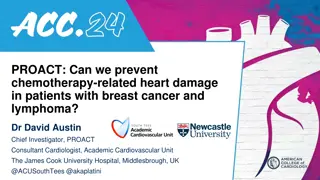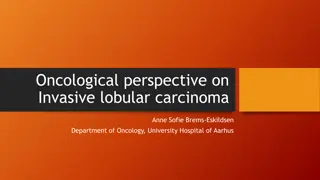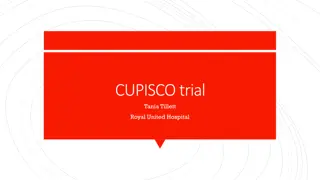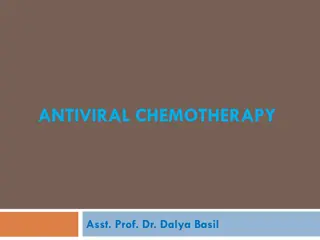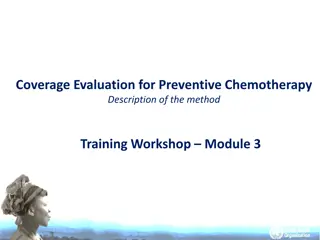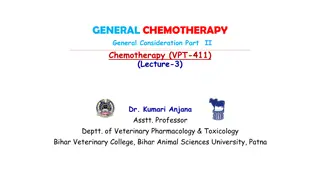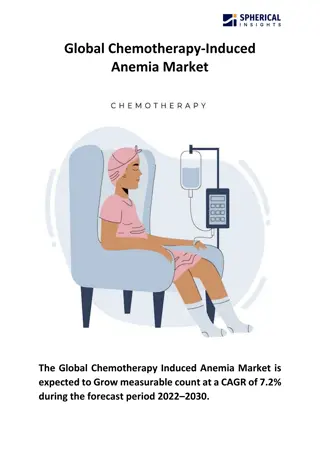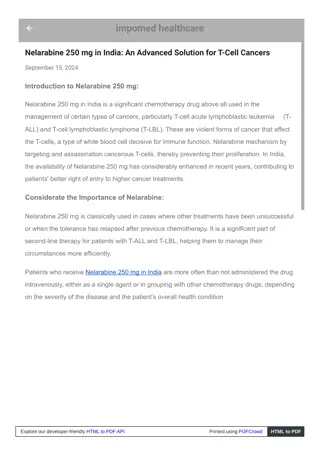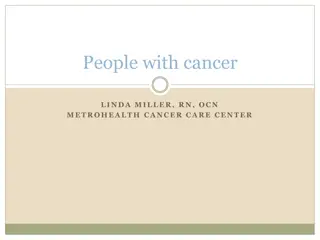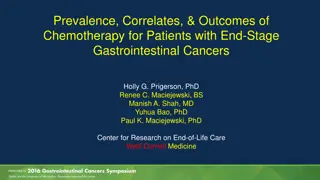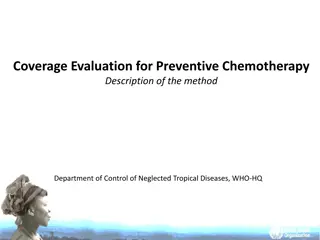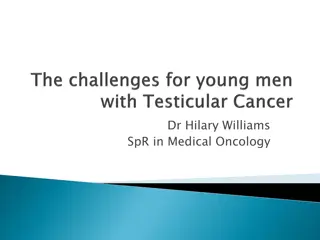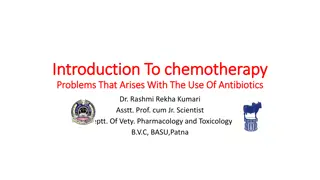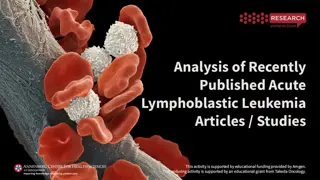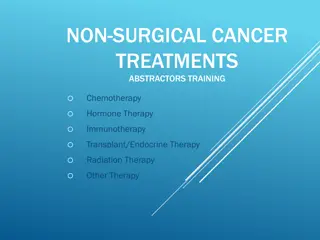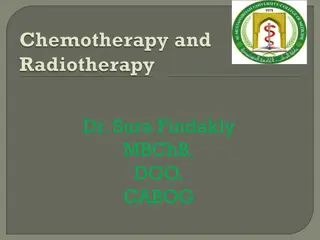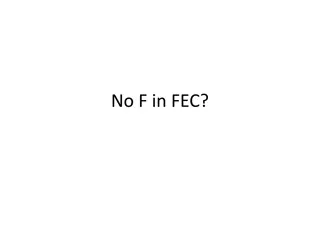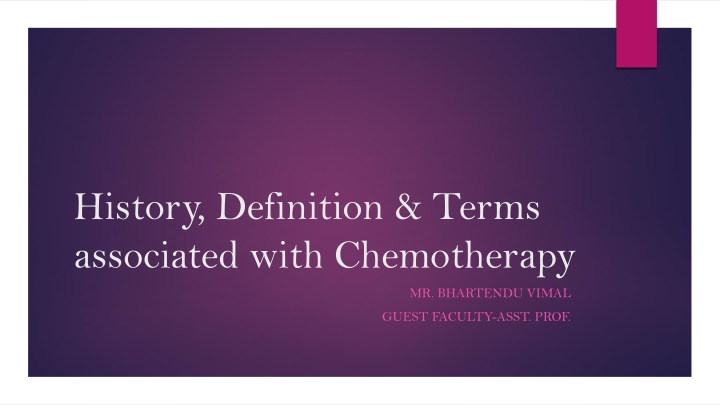
History and Definition of Chemotherapy: Evolution of Therapeutics
Explore the historical aspects and evolution of chemotherapy, from Paul Ehrlich's pioneering work to modern antimicrobial drugs like penicillin. Learn about the three phases of chemotherapy history and the contributions of key figures like Domagk and Fleming.
Download Presentation

Please find below an Image/Link to download the presentation.
The content on the website is provided AS IS for your information and personal use only. It may not be sold, licensed, or shared on other websites without obtaining consent from the author. If you encounter any issues during the download, it is possible that the publisher has removed the file from their server.
You are allowed to download the files provided on this website for personal or commercial use, subject to the condition that they are used lawfully. All files are the property of their respective owners.
The content on the website is provided AS IS for your information and personal use only. It may not be sold, licensed, or shared on other websites without obtaining consent from the author.
E N D
Presentation Transcript
History, Definition & Terms associated with Chemotherapy MR. BHARTENDU VIMAL GUEST FACULTY-ASST. PROF.
Historical aspects of therapeutics The importance of therapeutics known after the remarkable work by Paul Ehrlich, known as father of chemotherapy He introduced immunological approach. chemical approach of killing /inhibiting microorganism from Therapeutics is a branch of medical science dealing with the application of remedies to diseases Drug treatment of diseases (chemicals- synthetic /microbial organ -antibiotics) caused by invading organisms is referred to as chemotherapy. Antimicrobial drugs are the greatest contribution of the present century to therapeutics.
Initially the term chemotherapuetic agent was restricted to synthetic compounds. Later, the term Antimicrobial agent (AMA) is used to designate synthetic as well as naturally obtained drugs that attenuate microorganisms. The history of chemotherapy may be divided into 3 phases. The period of empirical use - mouldy curd by Chinese on boils, chaulmoogra oil by Hindus in leprosy, chenopodium by Aztecs for intestinal worms, mercury by Paracelsus (16th century) for syphilis, cinchona bark (17th century) for fevers.
Ehrlich's phase of dyes and organometallic compounds (1890-1935) - With the discovery of microbes in the later half of 19th century and that they are the cause of many diseases: Ehrlich proposed the idea that if certain dyes could selectively stain microbes, they could also be selectively toxic to these organisms, and tried methylene blue, trypan red etc. He coined the term chemotheraphy because he used drugs of known chemical structure (that of most other drugs in use at that time was not known) and showed that selective attenuation of infecting parasite was a practical proposition.
The Modern era of chemotherapy was ushered by Domagk in 1935 by demonstrating the therapeutic effect of Prontosil, a sulfonamide dye, in pyogenic infection. It was soon realized that the active moiety was paraamino benzene sulfonamide, and the dye part was not essential. Sulfapyridine was the first sulfonamide to be marketed in 1938. The remarkable efficacy of modern antimicrobial drugs still retains the art of making miracles and considered to be 'Magic bullets'. The phenomenon of antibiosis was demonstrated by Pasteur in 1877: growth of anthrax bacilli in urine was inhibited by airborne bacteria. Fleming (1929) found that a diffusible substance was elaborated by Penicillium mould which could destroy Staphylococcus on the culture plate. He named this substance penicillin but could not purify it.
Chain and Florey followed up this observation in 1939 which culminated in the clinical use of penicillin in 1941. In the 1940s Waksman and his colleagues undertook a systematic search of Actinomycetes as source of antibiotics and discovered streptomycin in 1944. This group of soil microbes proved to be a treasure-house of antibiotics and soon tetracyclines, chloramphenicol, erythromycin and many others followed. All three group of scientists Domagk, Fleming-Chain-Florey and Waksman received Nobel Prize for their discoveries. In the past 40 years emphasis has shifted from searching new antibiotic producing organisms to developing semisynthetic derivatives of older antibiotics with more desirable properties or differing spectrum of activity.
MILESTONES IN THE DEVELOPMENT OF CHEMOTHERAPY 1929 Penicillin discovered in England 1932 Sulphonamide (Prontosil) discovered in Germany 1937 1stsulphonamide released 1938 Serious infections respond to sulphonamides. 1939 Gramicidin discovered in U.S. 1940 Florey demonstrated penicillin s effectiveness. 1942 Penicillin introduced in Eng. & U.S. 1943 Streptomycin discovered in U.S. 1943 Bacitracin discovered in U.S.
1945 Cephalosporin discovered in Italy 1947 Chloramphenicol discovered in U.S. 1947 Chlortetracycline discovered in U.S. 1949 Neomycin discovered in U.S. 1950 Oxytetracycline discovered in U.S. 1952 Erythromycin discovered in U.S. 1954 Penicillin-resistant infections become clinically significant 1956 Vancomycin discovered in U.S. 1957 Kanamycin discovered in Japan
1960 Methicillin introduced in Eng. & U.S. 1961 Ampicillin introduced in Eng. 1961 Spectinomycin reported in U.S. 1963 Gentamicin discovered in U.S. 1964 Cephalosporins introduced in Eng. 1966 Doxycycline introduced in U.S. 1967 Clindamycin reported in U.S. 1968 Gentamicin-resistant pseudomonas and methicillin-resistant staphylococcal infections become clinically significant.
1969 Amikacin discovered 1970 In Early 70s, increasing trend of nosocomial infections due to opportunistic pathogens. 1971 Tobramycin discovered in U.S. 1972 Cephamycin (cefoxitin) discovered in U.S. 1972 Minocycline introduced in U.S. 1973 Carbenicillin introduced 1974 Ampicillin-resistant infections become frequent. 1978 Expanded spectrum cephalosporin Cefoxitin introduced. 1979 Oral cephalosporin with improved activity, Cefaclor introduced
1981 Anti-pseudomonal cephalosporin Cefotaxime introduced. 1981 First oxa- -inhibitor, Moxalactam introduced. 1983 Clavulanic acid-amoxycillin introduced. 1985 Norfloxacin introduced. 1987 Newer quinolones introduced for systemic use.
Terms and Definitions Drug is any chemical agent except food that is used to promote or safeguard the health of human beings or animals. It is also defined as any substance or product that is used or intended, to be used to modify or explore physiological systems or pathological states for the benefit of the recipient. The word drug is derived from a French word Drogue meaning a dry herb. Over the counter drugs are those preparations that can be sold without any prescription because they can be adequately labelled for layman use. Prescription drugs are drugs that can be veterinarian/physician/aqua clinicians based on a prescription. They are also known as legend drugs. Dose of the drug is an estimate amount of a drug, that when administered by a particular route to a certain species is most likely to produce a certain intensity of response. It is the quantity of medication to be administered at one time. Dosage is the determination and regulation of doses. used only on the order of a licensed
Posology is the study of the medicine dosages, which varies with the species of animals, the intended effect of the drug and the individual tolerance or susceptibility. Loading dose is one or a series of doses that may be given at the onset of therapy with the aim of achieving the target concentration rapidly. Threshold dose is the lowest amount or exposure level of a medicine or other toxic substances at which a specified and measurable effect manifests or in other words this is the minimal dose amount of medicine needed to obtain a desired therapeutic reaction. Maximum permissible dose is the largest amount of a medicine that one may safely receive within a specified period of time according to recommended limits set by the drug regulatory agencies. The specific amounts vary with age and circumstance. Therapeutic dose or curative dose is the amount or quantity of medication required to produce the desired outcome. Median curative dose or Median therapeutic dose (CD50) is a dose that abolishes symptoms in 50 per cent of test subjects.
Median effective dose (ED50) is a dose that produces the desired effect in 50 per cent of a population. Median infective dose (ID50) is the amount of pathogenic microorganisms that will produce demonstrable infection in 50 per cent of the test subjects. Median lethal dose (LD50) is the quantity of an agent that will kill 50 per cent of the test subjects or individuals in a large group or population. Median tissue culture infective dose (TCID50) is the amount of a pathogenic agent that will produce infection in 50 per cent of cell cultures inoculated. Minimum lethal dose is the smallest amount of toxin that will just kill an experimental animal. Reference dose is an estimate of daily exposure to a substance that is assumed to be without appreciable risk; it is calculated using the no observed adverse effect level and is more conservative than the older margin of safety.
Half-life withdrawl period: The half-life of a drug is an estimate of the period of time that it takes for the concentration or amount in the body of that drug to be reduced by exactly one half (50%). The symbol for half-life is T . Dose response relationship or exposure response relationship is the magnitude of the response of an organism, as a function of exposure (or doses) to a stimulus or stressor (usually a chemical) after a certain exposure time. A dose response relationship is being described by plotting the graphical representation of dose response curves. Potency is the concentration (EC50) or dose (ED50) of a drug required to produce 50% of that drug's maximal effect. In the field of pharmacology, potency is a measure of drug activity expressed in terms of the amount required to produce an effect of given intensity. Efficacy (Emax) is the maximum effect which can be expected from a particular drug (i.e. when the magnitude of effect is reached, increasing the dose will not produce a greater magnitude of effect)
Therapeutic index (TI; also referred as therapeutic ratio) is a quantitative measurement of the relative safety of a drug which is a comparison study of the amount of a therapeutic agent that causes the therapeutic effect to the amount that causes toxicity. TI determines the lethal dose of a drug for 50% of the population (LD50) divided by the minimum effective dose for 50% of the population (ED50).

